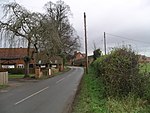Offchurch Bury is a manor house one mile north-west of the centre of the village of Offchurch, Warwickshire, England. It is supposed to represent the site of a palace of the Anglo-Saxon King Offa of Mercia (d.796), after which Offchurch is named, "bury" being a corruption of "burh" meaning a fortified place. William Dugdale in his Antiquities of Warwickshire (1656) stated concerning the manor of Offchurch:
In one part of the lordship is a place called "the Berry" which signifies no less than "burgus" or "curia" and accordingly 'tis said that Offa King of Mercia in the Saxon Heptarchy had here a palace".The Latin word burgus signifies "small fortified position or watch-tower usually controlling a main routeway", which suits the position of Offchurch, situated almost adjacent to the Fosse Way (now the B4455 Road), an important Roman road linking (on this stretch) the large Roman camps of Cirencester and Leicester.
Parts of the manor house (surviving pre-1954 demolition) dated from the reign of King Henry VIII (1509-1547) and were said to be connected with Coventry Priory, but most is 19th century. In 1954 about three quarters of the house was demolished, including the entire Tudor south block comprising servants' quarters, and on the north side the 17th century dining room and morning room, to form the present smaller house, comprising the single south-facing entrance block with Strawberry Hill-Gothic style battlemented facade and Tudor-arched windows, containing the drawing room and inner hall. It is in private occupation and not open to the public, although the park is occasionally used for equestrian events. The tranquility of the estate has been marred in recent years by the encroachment of the suburbs of Leamington Spa.












